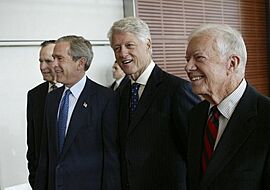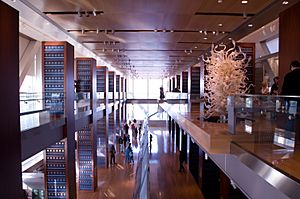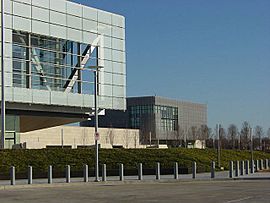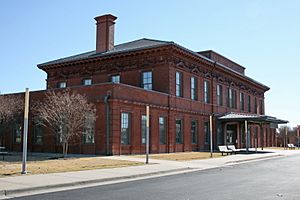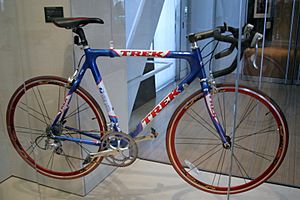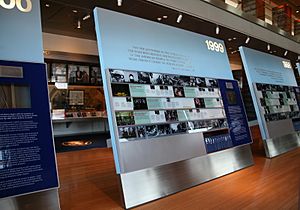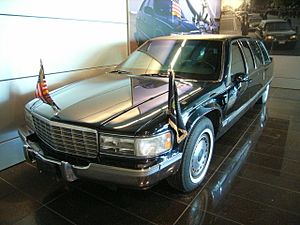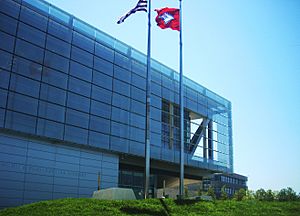Clinton Presidential Center facts for kids
Quick facts for kids William J. Clinton Presidential Library and Museum |
|
|---|---|
 |
|
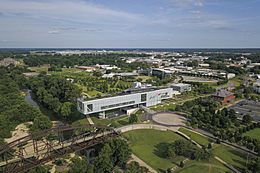
Aerial photo of the William J. Clinton Presidential Center and Park (center) and the Clinton School of Public Service (right)
|
|
| General information | |
| Location | 1200 President Clinton Avenue, Little Rock, Pulaski County, Arkansas, United States |
| Coordinates | 34°44′47″N 92°15′30″W / 34.746433°N 92.258463°W |
| Named for | William Jefferson "Bill" Clinton |
| Construction started | December 5, 2001 |
| Inaugurated | Dedicated on November 18, 2004 |
| Cost | $165 million USD |
| Management | National Archives and Records Administration |
| Technical details | |
| Size | 152,000 square feet (14,100 m2) |
| Design and construction | |
| Architect | Polshek Partnership |
The William J. Clinton Presidential Library and Museum is a special place in Little Rock, Arkansas. It holds the official papers and gifts from Bill Clinton's time as the 42nd president of the United States. He was president from 1993 to 2001. This library is part of a larger center. It includes the Clinton Presidential Library, offices for the Clinton Foundation, and the University of Arkansas Clinton School of Public Service. It was the thirteenth presidential library built in the U.S.
The center sits on about 17 acres (6.9 hectares) of land. It is right next to the Arkansas River. The main building was designed by Polshek Partnership, LLP. It looks like it hangs over the river. This design reminds people of Clinton's promise to "build a bridge to the 21st century." The library itself is very large. It has 68,698 square feet (6,382.4 square meters) of floor space. The archives here are also huge. They contain 2 million photos, 80 million pages of documents, 21 million e-mails, and 79,000 items from Clinton's presidency.
The museum shows many items from Clinton's eight years as president. You can see full-size copies of the Oval Office and the Cabinet Room from his time.
Contents
History of the Library
Preliminary plans for the library started in 1997. Construction began on December 5, 2001. The whole project cost $165 million. This money came from over 112,000 private donations. The City of Little Rock also gave 11.5 million dollars worth of land. The center covers 152,000 square feet (14,100 square meters) within a 28-acre (11-hectare) park.
Dedication Ceremony
The Clinton Presidential Center officially opened on November 18, 2004. About 30,000 people came to the ceremony. Famous people like Willie Mays and Robin Williams were there. Bill Clinton gave a 20-minute speech. Four U.S. presidents were on the same stage. These were Clinton, Jimmy Carter, George H. W. Bush, and George W. Bush. All three other presidents also spoke at the event.
Fifth Anniversary Celebration
On November 17, 2009, the library celebrated its fifth birthday. Bill Clinton gave a speech to about 1,000 people. He talked about important topics like health-care reform. He said the center was a good place for such discussions.
Exploring the Center
Main Building Features
The main building has five floors. It includes 20,000 square feet (1,900 square meters) of exhibit space. There is also the Great Hall for events and a restaurant called Forty Two. Bill Clinton was the 42nd president, which is why it's called Forty Two. On the top floor, there is a private penthouse used by Clinton. In 2007, a "Rooftop Garden" was added to the library's roof.
The exhibits inside the building were inspired by the famous Long Room at Trinity College, Dublin. Clinton saw this room when he was a student. On the first floor, you can see the special car, Cadillac One, that Clinton used as president. The second floor has the main gallery. It features a 110-foot (34-meter) timeline. This timeline shows each year of Clinton's presidency. There is also a theater and copies of the Oval Office and Cabinet Room.
Archives Building
Between 2000 and 2001, many large planes moved tons of President Bill Clinton's papers and gifts. They were moved from an air force base to Little Rock. These items were stored until the library was ready in 2004.
The archives are in a building connected to the main one. They are the first presidential archives to include electronic information. The total amount of records is 35,686 cubic feet (1,010.5 cubic meters). This is the most of any presidential archive. The archives are kept underground. This protects them from sunlight damage.
Clinton Presidential Park
The Clinton Presidential Park covers almost 30 acres (12 hectares) of land. It is right by the river, next to the museum. This area used to be an old warehouse district. Now it is a beautiful park. The park has a fountain plaza called Celebration Circle. The main buildings are around this circle. It also has an arboretum (a tree garden), an amphitheater, and a children's play area.
Choctaw Station Building
Choctaw Station is an old redbrick train station. It opened in 1901. It was used for train service until 1967. This building now houses the University of Arkansas Clinton School of Public Service. It also holds the Clinton Public Policy Institute and the Clinton Foundation. The station was renovated and is now 13,200 square feet (1,226 square meters).
The Clinton Park Bridge
The 1899 Rock Island Railroad Bridge crosses the Arkansas River. It used to be a train bridge. Now, it has been turned into a walking bridge. It connects to North Little Rock. Fundraising for the bridge was completed in 2010. Construction started on May 28, 2010. On September 30, 2011, Clinton spoke at the bridge's opening ceremony. It opened to the public on October 2, 2011.
Museum Store
The Clinton Museum Store is now located in the library lobby. For a while, it was in a different area. This was due to legal rules about state development funds. But those rules changed, and the store moved to the library in 2016.
Museum Exhibits
The Clinton Library has many items from Clinton's time as president. You can see his special presidential car, Cadillac One, on the first floor. The second floor has the main gallery. It includes a 110-foot (34-meter) timeline. This timeline shows each of Clinton's years as president. There are also 14 special areas that highlight different events from his time in office.
You can also find an orientation theater. There are full-size copies of the Oval Office and Cabinet Room from Clinton's presidency. The Oval Office exhibit is special. It is the only full-size model of the Oval Office in any presidential library. It was built using thousands of photos of the real office.
The timeline has eight large panels. Each panel is 18 feet (5.5 meters) wide. It starts with Clinton's first speech as president in 1993. The special display areas show things like the Oklahoma City bombing and peace efforts in Northern Ireland and the Middle East. You can also see personal letters to and from the Clinton family. These include letters from famous people and family photos.
The second floor also shows items from past state dinners. These are special gifts given to the president. You can see ceramics and other decorative pieces. There is also an exhibit about Clinton's saxophone. Another exhibit features his family pets, Socks the cat and Buddy the dog.
One of the 14 special areas is called The Fight For Power. It talks about the political struggles during Clinton's presidency. It shows how the Republican Party gained control of Congress in 1994. The exhibit designer said Clinton wanted this part to be very clear.
Building Design
Overall Look
The library complex has a modern design. It was created by James Polshek's Polshek Partnership Architects. The buildings are mostly made of steel and glass. The main building is built on a diagonal support structure. It was designed to be perpendicular to the river. This gives visitors a better view. The western side of the museum has a glass screen. This screen acts like a sunscreen for the building.
Environmentally Friendly Design
The library was built with many environmentally friendly features. This matches Clinton's interest in sustainable development. It earned a Silver certification for green building design in 2004. Later, in 2007, it received a Platinum Certification. The library's floors are made from recycled rubber tires. There are also charging stations for electric vehicles in the parking lot. In 2007, a rooftop garden was added. The garden collects rainwater. It is cared for without using gas-powered lawn mowers or chemical pesticides.
Economic Impact
After the library's location was announced, many new businesses opened nearby. Hotels, restaurants, and shops were built. The River Market district, a dining and shopping area, grew because of the library. Over $1 billion has been invested in downtown Little Rock. The world headquarters of Heifer International is also located close to the library.
The center has helped bring in about $2 billion in new projects. Since it opened, the library has had over 1.64 million visitors. In 2009, there were 302,583 visitors. In its first year (2004-2005), about 500,000 people visited.
Student Visits
The Clinton Presidential Center offers free entry to school groups. This includes homeschool groups and school staff. You just need to make a reservation.
The center also has four free-admission days each year. These are for Presidents' Day, the Fourth of July, President Clinton's birthday, and the anniversary of the center's opening.
See also
 In Spanish: Biblioteca y Museo Presidencial de William J. Clinton para niños
In Spanish: Biblioteca y Museo Presidencial de William J. Clinton para niños
- Presidential Records Act
- Presidential memorials in the United States


